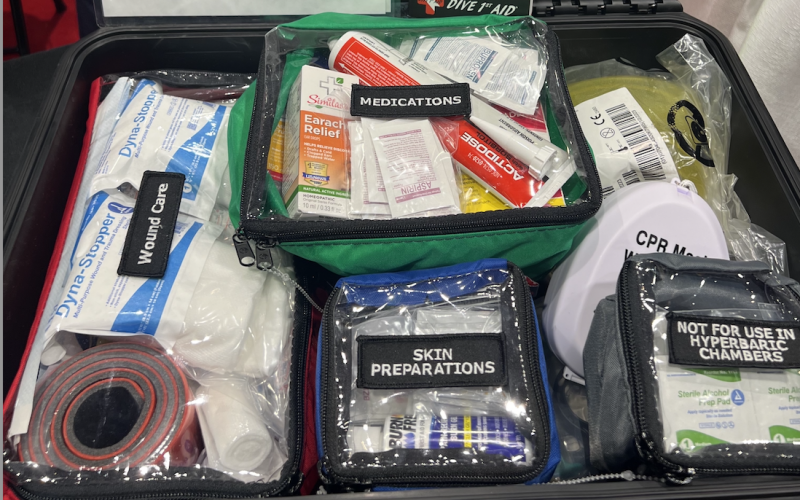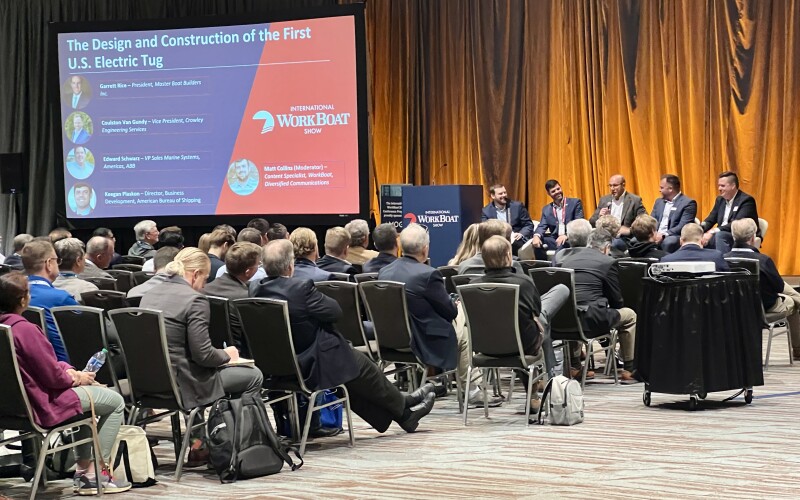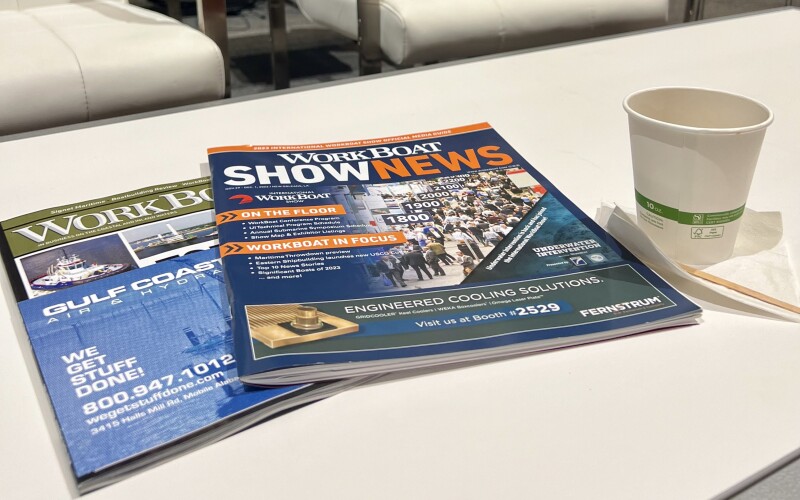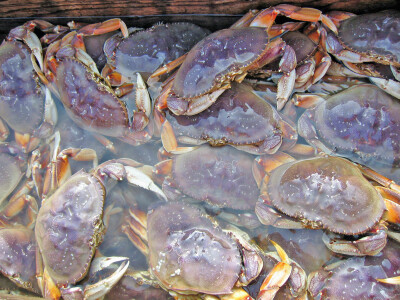When I entered the International WorkBoat Show in New Orleans for the first time on November 29, 2023, the first words that came to mind were “Dudes, everywhere.” And not the dudes we’re used to at the Pacific Marine Expo. There was not a fishing boot or hoodie in sight.
WorkBoat is a conference for the technical and business side of the industry. Unique even from the Seafood Expo North America in Boston each year, where international seafood products await grocers like Kroger, Hagen, or Safeway to place orders to stock their shelves. If PME is where fishermen come to reunite, and Boston is where seafood deals go down, WorkBoat is where the maritime “suits” come into play.
Conferences like these are important to stay on top of new technologies and products – you should have seen the new Coast Guard boat. Jet black with weapons lining the rails right out of a James Bond movie – yet, from the female perspective, I felt out of place. As a woman, I’m used to holding my own in a male-dominated environment, especially in fishing, but this was another level. (Also, I’m from the South, so this was not a geographical thing but a ubiquitous “bro vibe.”) I share to give the female perspective on navigating a space like this.
I was a super minority, passing another woman for every hundred men. And the women I saw barely acknowledged me or others along the way. I soon learned tunnel vision was a way of ignoring unwarranted stares. So, I mentally switched gears on how I’d approach each vendor, scanned the media guide for booths to visit, and set out to see what I could find relating to our wonderful world of commercial fishing.
After hitting a few vendors, I located the media booth to refuel on coffee, watched the mainstage event “The Design and Construction of the first U.S. Electric Tug,” chatted with a few National Fishermen colleagues, and enjoyed a round of the Maritime Throwdown and, quite possibly, the most inspiring emcee. Finally, I found my groove. Here’s what I discovered:

The maritime industry is essential, period.
You might be thinking, “duh,” but let me explain. While watching young contestants toss lines, make double configurations, navigate an obstacle course, and secure tie-offs at the Maritime Throwdown, I heard the emcee rattled off golden nuggets like, “Without professional mariners, we’ve got nothing” and “the maritime industry brings goods and services to your table,” and “think of everything you did today. It’s all thanks to our mariners and working waterfronts.” I got a little emo. He was right about all of it.
When I couldn’t locate the fishermen, I found the next best thing: ports and harbors to connect with commercial fishing communities. I started with Seacraft Shipyard in Fourchon and Amelia, La. They’ve been family-owned and operated since 1955 and insist on using only local craftsmen, workers, and vendors, so I knew they could get me to our people. A third-generation family member, Blake Haines, gave me contact information before I set off to find the St. Mary Parish Chamber of Commerce representatives, who also passed along emails to commercial fishing families. Connections like this remind me that no matter where we are in the maritime industry, we are all connected.
Maritime education
(Fishermen: these programs may also be great resources for finding crew.)
As the seascape changes (due to regulations, environment, etc.), so does the scope of careers on the water. Apparently, there are a lot, and I had no idea. If you’re interested in options and not sure where to start, higher education programs like Sea School, Texas A&M University Galveston, and South Louisiana Community College Commercial Diving are there to guide mariners to live their best sea lives.
For example, Sea School is a Coast Guard-approved maritime training school that offers the Apprentice Mate Steersman program, the training license for Mate of Towing. The course includes things like deck safety, rules of the road, emergency procedures, electronic navigation, towing operations, and anything about being knowledgeable and safe on the water. There’s an eighteen-day program where tuition covers room and board and a two-day program for upgrade courses. There are many options, and virtual classrooms are also available.
Texas A&M Maritime Academy is one of six state maritime academies that offer hands-on training to students preparing to earn a U.S. Coast Guard License or military service post-graduation. They focus on a holistic approach that includes marine transportation and trade, offshore and coastal engineering, fisheries, coastal tourism and health, and more. They also offer summers at sea aboard a 540-foot ship that “serves as a living laboratory for students to earn hands-on experience in ship navigation and marine engineering systems maintenance, safety and security, and attend class onboard.” They also travel to ports worldwide for added cultural exposure and networking opportunities. Visit www.tamug.edu for more information.
South Louisianna Community College is Louisiana's only state-funded accredited dive program where you can learn basic underwater skills and safety practices. It’s a two-year state college that runs about eight thousand for seven months. Cost varies depending on whether you’re in-state or out-of-state. Comparatively, this is a fraction of the cost of other courses. You can learn more at www.solacc.edu/diving
There are also eLearning courses by Moxie Media that cover maritime interests such as basic first aid, cargo safety, conducting onboard drills, drug and alcohol awareness, security, safe line handling, you name it. These courses would be great to implement with hands-on training as well. You can find more at www.moxietraining.com.

Custom emergency kits
Happening upon Dive 1st Aid was one of my highlights. Dive 1st Aid is a small company that creates significant customizable impacts through custom emergency kits. Each kit is based on the mariner's needs and demands, and because Dive 1st Aid has a special license, they can add you and your crew’s prescriptions to each kit so you’re never without. All products they use are made in the U.S.A. and can accommodate a crew of one to hundreds of crew. If you’re interested, www.dive1staid.com is where you’ll find them.

Mainstage events are the pulse of the modern maritime industry
The mainstage event, “The Design and Construction of the First U.S. Electric Tug,” made me think of this. As the panel described the versatility of hybrid batteries and their ability to assist engines and vessel safety, there’s the trade-off, like building a battery room in addition to the engine room to make it work.
“There’s no perfect solution,” a panelist said, encouraging attendees to look at all factors, such as cost, risk, Coast Guard regulations, and environmental advantages. It was interesting to learn that the Coast Guard also has challenges keeping up with new technologies aboard. Yet, change in this industry is the only constant.
“The fear of change is natural,” one panelist said. “But the jobs will change, and you have to adapt to it, or you’ll be left behind.”
As for the WorkBoat Show, I’d definitely go again. If you’re considering attending, I recommend blocking it off on your calendar for 2024. Not only to network and see what’s new but to understand the future of working waterfronts and how they may affect commercial fishing. You’ll most likely happen upon information that will help you stay one step ahead of the game.
Stay updated on the 2024 International WorkBoat Show by visiting https://www.workboatshow.com/







